|
Michael McFadyen's Scuba Diving - Rapid Bay Jetty
In mid-Feburary 2003, I travelled to South Australia, primarily to dive the wreck of HMAS Hobart. However, it would have been crazy to travel this far without taking the opportunity to do a dive to see a creature that we do not see at home in Sydney. This, of course, is the leafy sea dragon. I went here again in April 2022 and have updated the page considering the changes since 2003.
In New South Wales we get common (or weedy) sea dragons. They are generally found south of the Central Coast but we do not have leafy sea dragons. When organising the trip, it became obvious that the best spot to see leafys was Rapid Bay Jetty.
 | 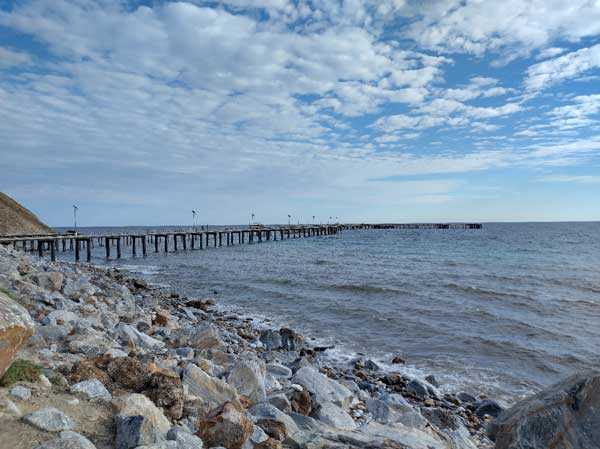 |
| Rapid Bay Jetty in 2003 | Rapid Bay Jetty in 2022 |
Located approximately 100 kilometres south of Adelaide, Rapid Bay is a small "locality" consisting of a few houses and a caravan park. The nearest town is Normanville. This small town is about 75 km south of Adelaide and for interstate visitors is the best place to stay, although in 2022 I stayed at Second Valley in an AirBNB place. See Normanville page for more information. From Adelaide, take the Main South Road and pass through Normanville and past Wirrina Cove Resort. About 8 km south of the Wirrina Cove turnoff you will see the access road to Rapid Bay.
The access road winds its way down to the sea, be careful as it is quite steep and winding in parts and there are quite a few sites where accidents have occurred. Once you hit the village, follow the signs to the beach and jetty and park as close as you can to the jetty.
The original Rapid Bay Jetty was built in 1940 as part of the limestone and dolomite mine located on the southern side of the bay. The mine was owned by BHP. The jetty was constructed of timber and in the shape of a T, but the end of the jetty has a slight kink to the right before meeting the end section. It was 488 metres long with a 200 metres long mooring section.
The main arm runs approximately north-south and the mooring section east-west. It is quite a large structure, standing about six metres off the water and about eight metres wide. Along the western side of the main arm there was originally a conveyor belt to carry the ore out to the awaiting vessel. There used to be a platform on the northern section, on the inside part of the arm, which was perhaps three or so metres off the water. This had a set of stairs from the main deck and a ladder down to the water.
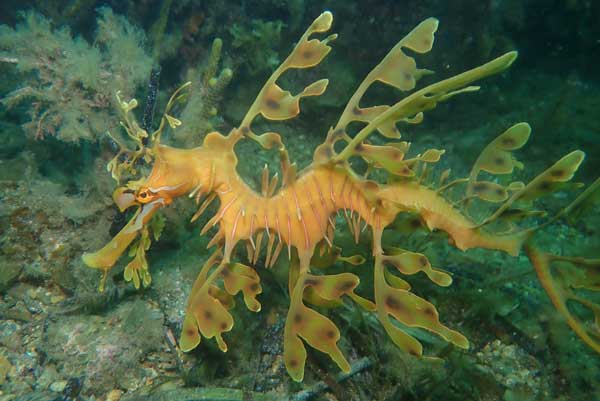 | 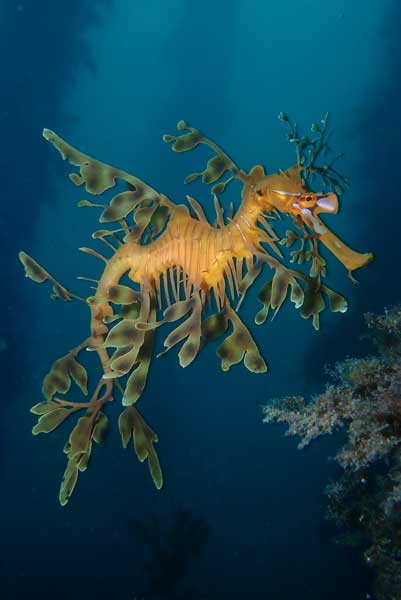 |
| One of the Rapid Bay Jetty leafies we saw in 2022 | Another leafy at Rapid Bay Jetty in 2022 |
In 1981 the mine was sold to Adelaide Brighton Cement and the jetty was last used in 1990. In September 1998 the conveyor belt was removed. In 2003 the jetty is in fairly good state of repair, but there was some damage to the decking and I read in DIVE Log at that time that there was some doubt about whether the jetty would be maintained in a condition that would permit its continued use by divers and fishers.
As indicated above, the jetty was very long and it was also about 100 metres from the closest parking spot to the start of the jetty. Many local divers have manufactured or adapted equipment to enable dive gear to be wheeled out to the dive entry point. Some use converted trolleys and home made items to make it a bit easier. I can attest that your gear (even a small tank like I used) gets as heavy as a bag of cement by the time you are out at the end. However, it is worth it and if you are local to Adelaide, it is worth taking along some kind of device to transport your gear (eg a trolley, golf buggy etc).
Anyway, the old jetty started falling apart and a few sections of deck and supports fell into the sea and was closed in December 2004 to the public. The South Australian Government declined to repair it. Eventually a new jetty was built and it opened in March 2009. This is parallel to the old jetty but only runs about half the distance out. The dive here is still under the old jetty, most of which is still in place, although more sections fell into the ocean in January 2022.
Once you are at the end of the new jetty, you will see a set of stairs down to a couple of small platforms from where you enter the water. The platform you use will depend on the tide height. Once you have your fins and mask on, enter the water and swim over to the old jetty. Alternatively, you can drop straight to the bottom here and then follow some star pickets across to the old jetty (remember these for your return trip). Once you reach the old jetty, descend and start the dive.
Straight away you will notice heaps of junk, old piles and timber sections from the jetty, parts of conveyor belt and other items. head to the north and follow the very obvious jetty piles. It is probably best to go relatively quickly as the best place to see the leafy sea dragons is one at the T section. Once you get to the T (remember there is a kink to the right before this), turn left as it is said this is the best spot to see them.
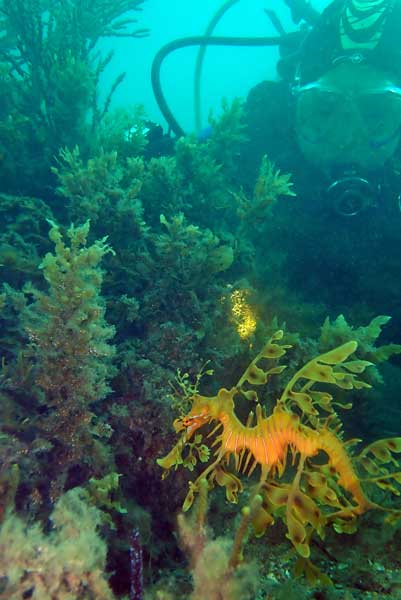 | 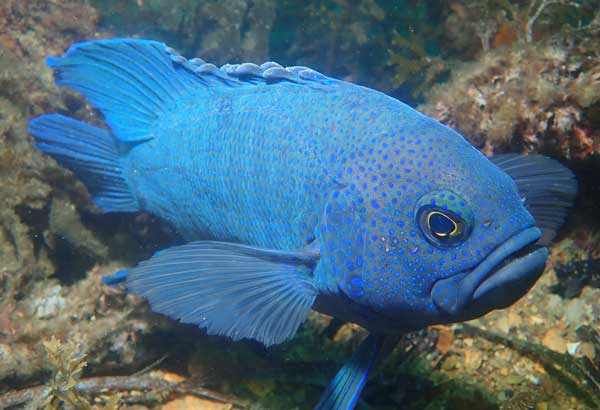 |
| John McPherson with a leafy in 2022 | A western blue devilfish in 2022 |
Stick to one side of the jetty (say the open sea side) and return along the other. This way you see more of the dive site. There are numerous pylons holding up the jetty, with huge amounts of growth on the timber piles. The junk has heaps of growth as well and there is a lot of kelp all over the place, as well as sea grass. As you go along you see huge schools of fish between the pylons. I do not know a lot of the names of these fish, as they are not the same as fish we get in New South Wales. Of the familiar ones, there were large schools of old wives, seapike, whiting as well as quite a few boarfish.
Of course, the main aim here is to find sea dragons and soon you will see the first of many. Of course, if you have luck like me (that is not real good), then you will see common sea dragons. I saw a total of 11 on my dive there in 2003. They are a bit different to the ones we get in NSW. Our common sea dragons are a very yellow colour, whereas the ones under the jetty (and I presume elsewhere in South Australia) are very green in colour. Maybe it is a adaption due to the kelp being a bit greener that our very yellow kelp. The ones we found were fairly small and we did not see any very large ones. They were quite easy to spot, swimming in and out of the kelp and sea grass.
Some other strange fish I saw included a very small green fish that looked a bit like a blade of sea grass and, of course, swam in and around the same grass. These fish lived in small schools. There were also some very ugly fish, with large eyes and spines along its back. I have not been able to find them in any fish book I own. Many other species I saw were also fish not seen (normally?) in NSW.
Once I got to the end of the jetty, I turned around and came back along the shore side of the jetty. More common sea dragons were seen. Along with the junk, I saw things like chairs that had blown off the jetty lying on the bottom. After 45 minutes I had still not seen a leafy sea dragon and we were at the T intersection so I turned right and went along the main section of the jetty. A short distance down the jetty I finally found what I was here to see, a leafy sea dragon. So tiny, so fragile looking, so beautiful! What a magnificent fish! I videoed it for quite a while and it was fantastic to finally see one in real life.
Goal attained, I headed back to the end section of the jetty and did a bit of exploring on the northern end before returning to the dive platform on the old jetty (remember this is 2003). This is where it got a bit hard. My buddy climbed onto the ladder and removed his fins before climbing up the ladder to the platform. He then took off his tank and came back down the ladder to collect my fins and then my video camera. Only then could I climb the ladder. If I was a regular diver here, I would have invested in a couple of long ropes and clips and hang these off the platform to enable the camera and perhaps my BCD and tank to be connected and then hauled up once I got to the platform.
Now you swim back along the main part of the jetty to where you joined it and then across following the star pickets to the new jetty.
Again, the walk back to the car park is a long and tiring event, but at least I am cool for the return trip.
This is a great dive, one of the best shore dives I have done in Australia (nothing beats the Coolidge as a shore dive). If you a visiting from outside South Australia, or even an Adelaide diver, take the effort to do this dive.
| 
 v6.00.307 © 2003-2005
v6.00.307 © 2003-2005